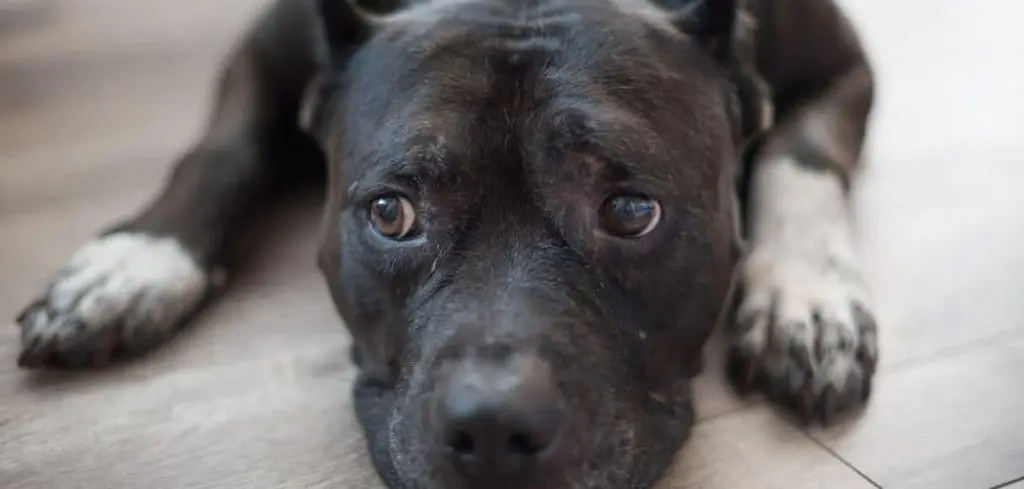Panting is a normal way for dogs to regulate their body temperature, but when a dog is panting while just sitting, it can be concerning.
Dogs normally pant after exercise or excitement, but panting at rest may indicate a medical issue that needs attention.
We outline the common causes of panting while just sitting in dogs, what you can do at home, and when to seek veterinary help.
Table of Contents
Dog Panting and Just Sitting — Why It Happens
When a dog is panting while just sitting, it often signals discomfort, pain, or internal stress rather than normal cooling. This can happen due to anxiety, overheating, or underlying health issues such as heart, lung, or metabolic conditions that make breathing harder even at rest.
Some medications or hormonal imbalances, like Cushing’s disease, can also trigger panting when the dog is inactive.
Because panting at rest is not typical behavior, especially in a calm or cool environment, it’s important to monitor for other symptoms like lethargy, coughing, or restlessness and consult a veterinarian if it persists.

Dog Panting and Just Sitting: Common Causes
Heat Stress or Overheating
Dogs may pant while sitting if they are overheating. This can happen even when they are not active, particularly in hot environments, in dogs with thick coats, or in brachycephalic breeds like Bulldogs and Pugs.
Signs include heavy panting, drooling, restlessness, and warm ears or body. Overheating is dangerous and can lead to heatstroke, which requires immediate attention.
Read more: Dog Panting and Just Laying Around (Why inactivity matters)
Anxiety or Stress
Panting can be a sign of anxiety even when a dog is sitting still. Situational stressors such as loud noises, separation from owners, or changes in the environment can trigger this response.
Other indicators include trembling, whining, pacing before sitting, and avoidance behavior. Providing a calm environment and comforting your dog can help reduce anxiety-related panting.
Pain or Discomfort
Pain is a frequent reason for panting while inactive. Dogs suffering from arthritis, spinal issues, or internal discomfort may prefer to sit rather than move, and panting may accompany the discomfort.
Look for stiffness, limping, reluctance to move, or unusual postures. Veterinary assessment is important for proper pain management and to prevent worsening of the condition.
Heart or Respiratory Problems
Panting while just sitting can signal underlying heart or lung issues. Heart disease, congestive heart failure, or respiratory conditions can impair oxygen circulation, causing labored breathing even at rest.
Symptoms to watch include coughing, fatigue, weakness, and a rapid heartbeat. Timely veterinary evaluation is crucial to manage these potentially serious conditions.
Fever or Illness
Systemic illness or fever may cause panting even when sitting still. Infections, metabolic disorders, or inflammatory conditions can make dogs lethargic and pant.
Other signs may include loss of appetite, vomiting, diarrhea, or changes in behavior. A veterinary visit can identify and treat the root cause effectively.
Obesity or Low Fitness
Overweight dogs or those with low fitness levels may pant while sitting. Excess weight puts extra strain on the cardiovascular and respiratory systems, making it harder to regulate temperature and maintain energy.
Signs include lethargy, shortness of breath during minor activity, or labored breathing at rest. Gradual weight management and regular low-impact exercise can reduce resting panting over time.
What to Do If Your Dog Is Panting and Just Sitting
Provide a cool and comfortable space for your dog to rest. Avoid overheating by monitoring the environment and ensuring proper ventilation.
Observe and record your dog’s behavior, noting when panting occurs and any other symptoms such as restlessness, whining, or reluctance to move. This helps your veterinarian understand the context.
Check for signs of pain or discomfort. Avoid forcing your dog to move if it seems reluctant, as this can worsen injuries or underlying conditions.
Ensure your dog stays hydrated and offer small, light meals if they are willing to eat. Dehydration or low blood sugar can intensify panting.
Reduce environmental stressors by providing a calm, quiet space. Gentle interaction, consistent routines, and reassurance can help minimize anxiety-induced panting.
When to Call or Visit Your Vet
Seek veterinary attention promptly if you notice:
Persistent or worsening panting at rest
Difficulty breathing, coughing, or bluish gums
Signs of severe pain or distress
Lethargy preventing normal movement
Loss of appetite, vomiting, or diarrhea
Suspected heatstroke or toxin exposure
Veterinarians can perform physical examinations, blood tests, imaging, and other diagnostics to identify heart, respiratory, or systemic issues contributing to panting while sitting.
Read more: Dog Panting and Jerking (Here’s why)
Key Takeaway
Panting while just sitting can indicate heat stress, anxiety, pain, heart or respiratory problems, illness, or obesity.
Observing your dog closely, providing a safe and comfortable resting environment, and seeking prompt veterinary care if symptoms persist are essential steps.
Early recognition and intervention help ensure your dog stays healthy, comfortable, and happy.
